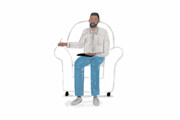Attitudes towards many mental illnesses have thankfully transformed in recent years, as people—encouraged by public figures sharing their own stories—have started opening up about depression and anxiety.
I live with borderline personality disorder (BPD)—a condition often stigmatized and misunderstood by the public and even mental health professionals.
Some other less visible mental illnesses, however, are still largely undiscussed and wrongly prejudged.
I know this first hand because I live with borderline personality disorder (BPD)—a condition often stigmatized and misunderstood by the public and even mental health professionals.
What is borderline personality disorder (BPD)?
Borderline personality disorder is a mental illness that affects our ability to regulate our emotions.
This emotional dysregulation can lead to impulsive behavior and intense, unstable relationships with others.
How many Americans have BPD?
Surveys have estimated the prevalence of borderline personality disorder to affect 1.6% of U.S. adults, though that number may be a lot higher as misdiagnosis as bipolar disorder is common.
The causes of BPD are not entirely clear, though there are thought to be genetic and environmental factors that may contribute.

9 symptoms of borderline personality disorder
I was diagnosed with BPD in 2015 at age 33.
According to the American Psychiatric Association's Diagnostic and Statistical Manual, fifth edition (DSM-5), there are nine characteristics, signs, and symptoms of borderline personality disorder:
Frantic efforts to avoid real or imagined abandonment by friends and family
Unstable personal relationships that alternate between idealization (“I’m so in love!”) and devaluation (“I hate her”). This is also sometimes known as "splitting"
Distorted and unstable self-image, which affects moods, values, opinions, goals and relationships
Impulsive behaviors that can have dangerous outcomes, such as excessive spending, unsafe sex, reckless driving, or misuse or overuse of substances
Self-harming behavior including suicidal threats or attempts
Periods of intense depressed mood, irritability or anxiety lasting a few hours to a few days
Chronic feelings of boredom or emptiness
Inappropriate, intense or uncontrollable anger—often followed by shame and guilt
Dissociative feelings—disconnecting from your thoughts or sense of identity or “out of body” type of feelings—and stress-related paranoid thoughts. Severe cases of stress can also lead to brief psychotic episodes.
Some people with BPD can be high-functioning in certain situations, while their private life may be in disarray.
When I investigated more afterward online with Dr. Google, I learned that the current complete diagnostic criteria for borderline personality disorder allows for 256 different combinations of symptoms that could lead to a diagnosis.
This means, essentially no two individuals with BPD are the same.
And there’s no such thing as a quick fix.
What BPD feels like
I’ve struggled with anxiety and depression since my teens, but didn’t begin experiencing BPD symptoms until my mid-twenties.
During my twenties, I developed a constant, unrelenting fear of abandonment, and I had a string of unstable relationships marked by bursts of explosive anger.
I also felt a chronic emptiness and had encounters with suicidal ideation.
My mood would change so dramatically and rapidly that I couldn’t keep track of how or why I felt the way I was feeling.
I'd oscillate between staggering highs and crushing lows—sometimes within minutes of each other.
My mood would change so dramatically and rapidly that I couldn’t keep track of how or why I felt the way I was feeling.
My brain would treat a minor inconvenience like a missed bus with the same intensity as getting fired from my job.
Destructive behavior had been my go-to coping mechanism. I drowned my emotions in alcohol and used self-harm to release emotional distress.
I would oscillate between staggering highs and crushing lows, sometimes within minutes of each other.
I'd spend days feeling like all my nerve endings were exposed—I was in constant emotional pain.
Ending my life often felt like the only option.
This is not uncommon.
BPD patients have an average of three lifetime suicide attempts, and as many as 10% will die by suicide.
After multiple psychiatric assessments, BPD was finally mentioned for the first time in 2015.
I was happy.
If my condition had a name—that meant it had a treatment. It was a relief.
What's it like to be in a relationship with BPD?
The more I read, the more I realized romantic relationships trigger my BPD.
I fall in love quickly and deeply and always prioritize a partner’s needs above my own.
As quickly as I fall in love, those feelings sour, and I find myself plotting my escape.
I become infatuated, and everything else feels insignificant.
Then, as quickly as I fall in love, those feelings sour, and I find myself plotting my escape.
Relationships, for me, are all or nothing—love or hate.
There’s no middle ground, and it’s exhausting.

Does BPD make it hard to make and keep friends?
When I fell in love, my friendships suffered because my emotional instability made me prone to irrational anger.
I'd be so obsessed with the object of my affection, and I'd take out my anxiety on my friends by lashing out at them seemingly at random.
I struggled to function at work—I could barely hold a conversation about something other than the person I was obsessed with.
I ended every relationship quickly (prematurely) because I feared abandonment so much that I was willing to break my own heart rather than let someone else do it.
It’s difficult to explain to other people how something as evidently innocuous as an unanswered call or text could cause a person like me with BPD to spiral. Every text message left on read led me to believe I was unworthy of anyone’s time, attention, or love.
I was willing to break my own heart rather than let someone else do it.
Being open with friends has helped to lift the burden of coping with BPD.
Living with any mental disorder is made a little easier when people close to us understand what we are going through. I was terrified of judgment and ridicule.
When I summoned the nerve to tell my friend that if she read a text from me, but didn’t reply to the message, I thought it meant that she hated me, she said, “That sounds really rough. I will always reply from now on.”
This, by itself, was a huge relief.
The stigmas and myths around BPD
I thought it would mean I’d get help with my condition right away, but I soon discovered that there’s a lot of misunderstanding and misconceptions around BPD—even from within the mental health community. Stigma still exists.
BPD sufferers are labeled “melodramatic,” “manipulative,” “attention-seeking,” even “self-absorbed.”
I know what it is like to read an academic text that suggests you are without compassion or to have medical professionals refuse to acknowledge your condition even exists.
BPD sufferers are labeled “melodramatic,” “manipulative,” “attention-seeking,” even “self-absorbed.”
In the five years since my diagnosis, I’ve become accustomed to the stigma, discrimination, and casual cruelty that can so often cloud conversations about BPD.
When I write about BPD and speak to fellow sufferers, they always ask for anonymity, fearing being “outed” will bring cruelty and judgment.
Several therapists even refused to work with me after learning about my BPD diagnosis. This rejection made me feel utterly worthless.
Treatment for borderline personality disorder
Being diagnosed with BPD can feel like a blessing and a curse.
The relief of having a diagnosis, something to build your hopes of a “cure” on, is regularly shattered by the reality that recovery can be tough and rarely follows a linear path.
Each individual with BPD is unique, so it can take some time to find a suitable treatment approach.
I was prescribed medication to stabilize my moods, and I quit drinking as it exacerbated my self-destructive tendencies.
Dialectical behavior therapy (DBT), a type of talk therapy that gives patients the skills to manage their emotions and improve their quality of life, is commonly recommended for BPD patients.
Several therapists refused to work with me after learning of my BPD diagnosis
But I couldn’t find any therapists who specialized in DBT near where I lived, so my condition—though diagnosed—went untreated by anything other than meds for over two years.
Eventually, I was able to start an online course of mindfulness-based therapy (MBT), which gave me the tools to regulate my emotions in triggering situations.
It took a long time to understand BPD isn’t who I am—it’s an aspect of me.
I’m fortunate that there are people in my life who love me, even on my days when I don’t love myself.
Find a therapist who treats borderline personality disorder
On the Monarch Directory by SimplePractice, you can find and book sessions with therapists who specialize in borderline personality disorder (BPD).
You can also see therapists who specialize in dialectical behavioral therapy (DBT), a type of therapy developed specifically to treat individuals with BPD. READ NEXT: BPD, and the 4 Other Most Misunderstood Mental Health Disorders
Searching for a great mental health therapist? Check out the Monarch Directory by SimplePractice to find licensed therapists near you with availability and online booking.
Biskin, R. S., & Paris, J. (2012). Diagnosing borderline personality disorder. Canadian Medical Association Journal, 184(16), 1789–1794. https://doi.org/10.1503/cmaj.090618
Chapman, J., Jamil, R. T., & Fleisher, C. (2020, November 30). Borderline personality disorder. StatPearls. StatPearls Publishing. Treasure Island (FL). Retrieved from https://www.ncbi.nlm.nih.gov/books/NBK430883
Paris J. (2019). Suicidality in borderline personality disorder. Medicina (Kaunas, Lithuania), 55(6), 223. Retrieved from https://www.ncbi.nlm.nih.gov/pmc/articles/PMC6632023/
Ruggero, C. J., Zimmerman, M., Chelminski, I., & Young, D. (2010). Borderline personality disorder and the misdiagnosis of bipolar disorder. Journal of Psychiatric Research, 44(6), 405–408. Retrieved from https://doi.org/10.1016/j.jpsychires.2009.09.011
Sansone, R. A., & Sansone, L. A. (2013). Responses of mental health clinicians to patients with borderline personality disorder. Innovations in Clinical Neuroscience, 10(5–6), 39–43. Retrieved from https://www.ncbi.nlm.nih.gov/pmc/articles/PMC3719460/
The National Institute of Mental Health (NIMH). (2021). Borderline personality disorder. Retrieved from https://www.nimh.nih.gov/health/topics/borderline-personality-disorder/index.shtml




